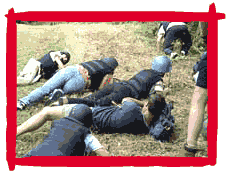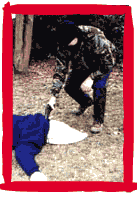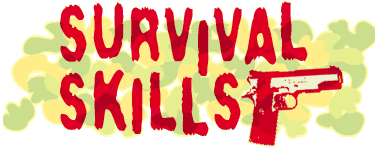 |
 |
 |
|
|||
|
Survival Skills Call me cowardly custard, yellow-belly, chicken, I don't care. I have no intention of going anywhere dangerous. So I feel a bit of a fraud at this training center in a large 18th century English country house an hour outside of London. The $300-a-day course is run by a bunch of ex-Royal marines. We start by looking at weapons.
Instructor: "There are obviously variations on pistols. This is made by Colt, an American make. It's a .45 caliber, a dumpy, heavy round." Machine-guns, pistols, rifles, anti-tank missiles, they're all passed around the room.
Instructor: "Pull the trigger and in about a second and a half it will fire 32 rounds. So, you don't have to be the world's best shot. You can just point it and fire and one of them is going to hit, hopefully, the person you're aiming at." 
They want us to be able to recognize the difference between these firearms when we come across them being waved round by armed terrorists and crazed gunmen on our travels. But frankly, I don't see the point. If someone thrusts one of these in my face it doesn't matter whether it's an Uzi or a Kalashnikov, I'm still going to mess my pants!
Instructor: "We're going to picture ourselves in West Africa this afternoon. We're going to go forward to meet up with a camera team who's doing a story about some guerilla leaders and fighters that are living in the woods. So, you're in a hostile environment." Next we're outside on a walk through the woods learning to spot danger signs. Our mission, should we wish to accept it, is to meet up with a camera crew in the jungle. But we have to turn back though, if we see anything dangerous. We're a shambles. We walk through a trip wire, miss empty bullet shell cases, and practically fall over a gun pointing at us from under some leaves. Finally we reach a pile of dismembered plastic dummies in blood soaked clothes. Our colleagues, I presume.
They're dead and if this had been for real, we would be too. We've got some learning to do. Suddenly we're under fake mortar fire. We all start running around, rolling in the mud looking for cover.
Instructor: "Is everybody alright? Mortar fire's much more serious than that, obviously. The ground shakes and the air becomes full of pieces of metal flying at hundreds of miles an hour, whizzing past. Don't move. Get on the floor and stay there. You've got no idea where they're going to fall so there's no point in moving around." Later we're shot at by snipers. We all drop to the ground and don't move. This time we were supposed to run for cover. It all gets very confusing. The following day things calm down a bit. We're taught how to spot land mines. Apparently the guys who lay them are trying to kill, for example, government troops, certainly not the locals who feed and shelter them. So they leave hidden messages marking out the danger zones: a couple of small branches pointing at the path, a twig through a leaf. They say a couple of years ago a camera crew who'd been on the course narrowly escaped death when they spotted one of these signs on a jungle path. They turned back and later learnt it was full of mines. But this doesn't seem very helpful advice for a simple holiday-maker like me. Much more useful is the class on map reading and how to use a compass. We're taking orienteering, but I seem to upset the ex-Sergeant Major who's leading our group by getting it wrong all the time. He screams at me: "Ave you got an effin problem young man?" I feel like Private Benjamin. I want to say: "Actually yes I have. I don't like your attitude. We're paying for this course, we deserve a bit of respect and courtesy." Instead I mumble, "No sir". 
I'm quite relieved when we get to the first aid course. Here we're taught how to give the kiss of life, stop someone choking on a chicken bone, bandage up a blood gushing wound. I've never done any first aid and I feel remiss for not having learnt this stuff sooner. We practice on each other.
Journalist: "Hello, can you hear me? Can you open your eyes for me? Can you open your eyes." Finally we're told it's time to put our new-found first aid skills into practice. We're going in the jeep to the sight of a mocked up car accident. Sounds fun, we think as we're piled inside. We drive off. Suddenly there's a loud bang, the jeep screeches to a halt and four masked men come running at us firing guns. We're dragged out, thrown face down into the mud and tight hessian sacks are put on our heads. Wedding rings, watches and other valuables are torn from us. It's only an exercise I keep thinking, but try telling that to your pounding heart as you're gasping to control your breathing and the only noise you can hear is sporadic gun fire. I'm dragged up, leant against a wall. I'm waiting to be shot when they take the sack off and I'm released. I'm not the only one shaken. Paul Henley works for the BBC.
Afterwards they try to justify why they put us through this experience. They tell the story of the 250-lb man who went berserk when they took his wedding ring because it hadn't been off his finger for fifteen years. In real life he'd have been shot. They warn us that losing things we're attached to emotionally can make us react irrationally, and I make a mental note not to take any valuables with me on future holidays. If I'm mugged I don't want to do anything stupid. And I think that may be the most useful thing I learned. Anyone can do this course--journalists, business people or tourists going somewhere risky. But is it worth it? I guess it's one of those things you don't find out until you come under fire or are actually taken hostage. And I'd rather not put the training to the test if you don't mind! From Hampshire in England, this is Martin Stott for The Savvy Traveler.
|
 | American Public Media Home | Search | How to Listen ©2004 American Public Media | Terms of Use | Privacy Policy |
